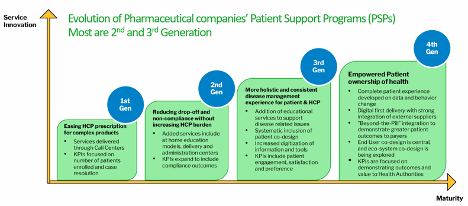The Architecture of Global, Scalable, Next-Generation Patient Support Programs
Patient support programs (PSPs) have an opportunity for growth and innovation.
Gregg Fisher

Jonathan Olsen

Conditions are ripe for a renaissance in patient support programs (PSPs). Brands are under pressure to demonstrate value by delivering outcomes to justify pricing and grow revenues, and patients support programs offer a path to deliver this value through adherence, persistence, and patient satisfaction.
The pharmaceutical patient support vendor landscape is burgeoning with new-to-world tools offering cross-channel-consumer experiences which integrate behavior change principles, advanced data, and digital technologies. Furthermore, many of these providers can shorten development cycles to three-to-four months from 18 months or more, by leveraging re-usable components and ways of working. Think: social/peer support, smart messaging, content management, machine learning, rapid journey design, agile code development, accelerated review cycles, rapid design, and testing. Finally, innovations in data science and real-world data offer firms the ability to directly measure the outcomes impact of patient interventions, a feat which was elusive even a decade ago.

The Challenges
As with much of digital transformation in pharmaceuticals, we witness pockets of PSP innovation in specific markets and only a small number of leading pharmaceutical companies who are building scalable fourth generation patient support experiences and realizing tangible benefits.1 Many Pharmaceutical companies are offering primarily second or third generation programs, and struggle to scale the isolated third or fourth generation innovations they have.
We observe several barriers that explain the current situation:
- Lack of executive belief in return on investment. While patient engagement managers recognize the missed opportunities, their senior leaders at the global and market levels are frequently not convinced of the ROI of PSP programs beyond supporting drug access. Faced with the choice of prioritizing a promotional effort or a support effort, many leaders will focus on promotion, and be satisfied with the status quo in their PSPs. This occurs even though the body of evidence supporting the return on modern PSP interventions is large and rapidly growing.2
- Lack of global empowered patient engagement teams to support program scaling. While large pharma companies have begun to build global patient engagement functions, in our experience many of these groups are underfunded and lack a clear institutional mandate to elevate patient service quality and efficiency.
- Lack of a global vision and strategy for next generation and scaling. While local efforts are essential to experimentation and demonstrating impact, only through coordinated global/regional and local efforts can organizations hope to scale next-generation patient support experiences.
- Perceived cost. Coupled with the lack of belief in ROI, comes a belief that advanced PSP programs are expensive and not affordable. This leads executives to view PSPs as a one-off marketing expense rather than investments in commercial capabilities that will deliver desirable returns. This mind-set in exacerbated by the fact that leaders often do not have visibility into the redundant legacy PSP investments made in different markets that collectively are more expensive than designing next-generation programs at scale. It also ignores the opportunity cost (measured in missed revenue) of deferring investments that would elevate adherence beyond their legacy programs, which often struggle to produce compelling results.
Recommendations
To overcome these barriers and realize the promise of patient engagement, we recommend pharma patient engagement teams (global and local) together with brand champions and senior leadership sponsors consider the following actions:
- Establish the business justification and centralize insights: through analysis, education, business case building. Proactively analyze business questions like “what are the benefits of achieving better outcomes?”, and “what is the cost of not doing so?”. Elevate the organization’s PSP knowledge by aggregating insights related to PSP performance across the organization, sharing best practices, learnings, and impact metrics. With unified commercial oversight of PSP impact, it becomes easier to develop compelling business cases that generate broad stakeholder buy-in.
- Seek out pilot partners. Many local market or brand teams recognize the need to improve an existing or create a new patient support program, but lack the knowledge, resources, or buy-in to plan and execute. By joining forces, the patient engagement team can provide much needed assistance in gathering patient insights, setting patient experience strategy, developing the business case, and even contributing supportive funds for execution to realize the benefits of scaling beyond the pilot markets.
- Design a patient engagement vision and idealized experience, with patients. Start by gathering insights. Co-design, which involves partnering with patients and HCPs is a preferred practice that enables understanding patient’s authentic needs, the leverage points to focus on and the idealized patient experience. Using input from the co-design process, the enhanced patient experience can be articulated in detail.3 This blueprint can then be used to define an implementation approach and budget.
- Plan implementation with scale in mind, including modular components and vendors. To improve scalability, maximize re-use of PSP components and increase speed to market of PSPs, careful thought must be given to the components and vendors that are used. The design of a cohesive digital experience for patients may involve multiple vendors, each serving different enrollment, experience, and human support functions. A detailed understanding of the vendor landscape makes it clear which vendor capabilities are the most important to apply to the desired patient experience. For example, certain vendors excel in drug reminder programs, others excel in private social network building, and still others excel in peer-to-peer coaching programs. Careful consideration of the PSP implementation architecture will ensure the various program pieces together properly, that multiple markets will be able to reuse the components and avoid expensive duplication of effort.
- Make the case for scale. When seeking funding, tailor the presentation to different stakeholders. To local colleagues, demonstrate how revenue lift will be achieved with assumptions derived from real world benchmarks. Program enrollees. Expected lift in days on therapy, break-even point, ROI. For global colleagues, quantify the savings or cost deferral of building a scalable solution.
- Implement in increments, and measure. Despite the best business case, funding may not be available to implement the full solution right away. Executives will seek evidence of program impact before releasing additional funds. Given this reality, careful thought should be given to what is the minimum viable product to launch with and what do subsequent releases look like. As pilot programs are deployed careful attention must be paid to measurement and optimization so refinements can be made before the program is further scaled.
Recommendations one and two will help you shape the environment in your company for PSP innovation. Recommendations three to six will help you build a patient experience strategy that is aligned to patient needs, has scale and speed to market built-in from the start, and is more likely to get funded.
Conclusion
Good architects know the importance of the adage: “measure twice, cut once.”
The opportunity for patient support innovation is large and growing. The business need is there, the patient need is there, the vendor landscape is there. What’s needed are more innovative programs that get funded. We hope the planning recommendations will inform and inspire bold patient engagement leaders and enable their patient support programs to deliver high quality patient experiences efficiently at scale.
Authors
Gregg Fisher, Managing Partner, The Stem – gfisher@thestem.com, www.thestem.com
Jonathan Olsen, Independent Consultant, Patient Engagement Technology Expert, Member, The Stem
Resources:
- Based on an analysis of publicly accessible patient support programs globally. Source: The Stem
- As cited in the Journal of Managed Care and Specialty Pharmacy, Abbvie Care’s 2019 study of its Patients Support Program for Humira demonstrated 29% improvement in adherence for PSP enrollees, 22% lower discontinuation, 35% lower disease-related medical costs, and 48.9 additional days on therapy. See also, BMJ Heart for impact of medication management apps on adherence.
- Ideally this work is done within input from patients from multiple markets with different profiles so the result is a scalable strategy with experience components that will serve small markets as well as large.
Addressing Disparities in Psoriasis Trials: Takeda's Strategies for Inclusivity in Clinical Research
April 14th 2025LaShell Robinson, Head of Global Feasibility and Trial Equity at Takeda, speaks about the company's strategies to engage patients in underrepresented populations in its phase III psoriasis trials.